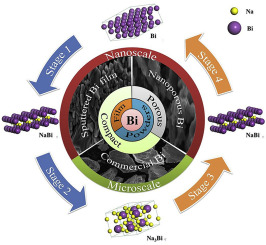Journal of Power Sources ( IF 8.1 ) Pub Date : 2018-01-12 , DOI: 10.1016/j.jpowsour.2018.01.017 Hui Gao , Wensheng Ma , Wanfeng Yang , Jiawei Wang , Jiazheng Niu , Fakui Luo , Zhangquan Peng , Zhonghua Zhang

|
Understanding the sodium (Na) chemistry is crucial for development of high-performance sodium ion batteries (SIBs). Nanostructured bismuth (Bi) has shown great potentials as an anode in SIBs, however, the Na storage mechanisms of Bi are still unclear. Herein, the operando X-ray diffraction (XRD) technique was utilized to probe the Na storage mechanisms of three Bi anodes (sputtered Bi film, nanoporous Bi and commercial Bi). Despite different morphologies and sizes, all the Bi anodes follow the same two-step reversible alloying/dealloying mechanisms (Bi ↔ NaBi ↔ Na3Bi) during the discharge/charge processes, associated with two voltage plateaus. As for the intercalation/deintercalation mechanism proposed for nanostructured Bi anodes in SIBs, we rationalize the reason why only the Bi phase is detected in the discharged/charged samples under ex-situ XRD conditions through addressing the stability issue of the Na-Bi system (NaBi and Na3Bi).
中文翻译:

钠离子电池中铋的钠储存机理:X射线操作衍射研究
了解钠(Na)的化学性质对于开发高性能钠离子电池(SIB)至关重要。纳米结构铋(Bi)作为SIBs的阳极具有很大的潜力,但是,Bi的Na储存机理尚不清楚。本文中,通过操作X射线衍射(XRD)技术来探究三个Bi阳极(溅射Bi膜,纳米多孔Bi和商用Bi)的Na储存机理。尽管形态和大小不同,但所有Bi阳极均遵循相同的两步可逆合金化/脱合金机理(Bi↔NaBi↔Na 3Bi)在放电/充电过程中,与两个电压平稳段有关。关于针对SIBs中的纳米结构Bi阳极提出的嵌入/脱嵌机制,我们通过解决Na-Bi系统的稳定性问题,合理化了在异位XRD条件下在放电/带电样品中仅检测到Bi相的原因( NaBi和Na 3 Bi)。











































 京公网安备 11010802027423号
京公网安备 11010802027423号